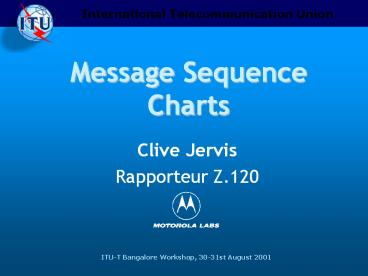Message Sequence Charts PowerPoint PPT Presentation
Title: Message Sequence Charts
1
Message Sequence Charts
- Clive Jervis
- Rapporteur Z.120
2
Message Sequence Charts ITU-T Standard Z.120
- Current Version MSC 2000
- Previous Version MSC 96
- Next Version MSC 2004
- Standard consists of
- graphical grammar
- ASCII grammar
- static dynamic semantics
- formal semantics, Annex B
- examples
- Topics
- Overview
- Uses
- Language
- Future
- Summary
- MSC is
- used widely in industry
- has good tool support
- strong ties to other ITU languages
3
Overview
msc call_set_up
mobile_2
base_1
mobile_1
network
base_2
up_call_req
up_call_req
down_req
down_req
call_ack
call_ack
up_call_resp
up_call_resp
down_resp
down_resp
- Intuitive, widespread informal use
- Focuses on external interactions rather than
internal behaviour - Only notation that shows complete system
interactions - Good for partial specifications - i.e. scenarios
- Can be used independently of other languages
- Universal data language interface
4
MSCs in the Lifecycle
MSCs Used Formally Throughout Lifecycle
System/Integration Testing
ITU, ETSI Standards
Test Generation
System Requirements
TTCN
Automation Requires Formal Languages
Test Generation
Box Testing
Box Requirements
TTCN
Code Generation
ASN.1 Everywhere!
Code Generation
SDL Design
Code
5
MSC Uses
Formality Enables Useful Tool Support
- Verification Validation
- feature interactions
- race conditions
- tracing
- Tracing
- model validation
- application code validation
- test validation
- Design Verification
- model checking
- SDL upholds MSCs
- Test Generation
- conformance testing
- test purposes (one-2- many)
- test specification (one-2-one)
Requirements VV
SDL Tracing
SDL Verification
TTCN Generation
6
Basic Features
msc call_expiration
base
manager
network
Time Progresses Downwards
initiate
handler
wait(5)
ready
handle call
call_set_up
- No linearity
- No synchronicity
- Interleaving
expired
terminate
- instance
- message
- timer
- co-region
- create
- reference
- local action
- stop
msc call_set_up
network
7
Semantics
- Single MSC defines a set of event traces
- Events interleaved
- Timing constraints can reduce possible traces
msc call_expiration
- A message consists of
- a send event
- a receive event
- Semantics prescribes
- no buffering mechanism
mobile
network
base
identify
initialise
receive initialise
send initialise
receive identify
Three traces!
send identify
receive identify
receive initialise
send initialise
receive initialise
receive identify
8
High-Level MSCs
Structuring MSCs
- References can be to
- basic MSCs or
- high-level MSCs
- start point
- end point
- reference
- branching
- looping
- parallel (not shown)
- guards (not shown)
Single telecom. feature may have gt100 basic
MSCs structured through 3 levels of high-level
MSCs
9
In-Line Expressions
Structuring event behaviour within an MSC
- In-line expressions
- alternative
- parallel
- optional
- loop
- exceptional
- Operands
- non-deterministic choice
- may be guarded
- events interleaved with those outside
expression
10
Time Constraints/Data
- Real-Time Constraints Message Contents
- Data Dependent Behaviour Parameterisation
- Time Constraints
- absolute (tracing)
- relative (specification)
- single point, intervals
- constrain regions
- Data
- static variables
- - parameterises MSC
- - global to MSC
- - also instances, etc.
- dynamic variables
- - local to instance
- - assigned in actions
- - declared MSC Document
- underspecification
- - dont care values
11
Instance Decomposition
Splitting an Instance Into Constituent Processes
msc call
network decomposed as network_call
base
manager
initiate
ready
set_up
msc network_call
- Hierarchical view of processes
- Instance structure defined in enclosing MSC
Document - Internal messages hidden in upper view
manager_handler
base_handler
initiate
ready
initiate_set_up
set_up
12
Other Features
MSC a Comprehensive Specification Language
- MSC Document
- module encapsulation
- all declarations
- definition of data interface
- inheritance/decomposition
msc call
- Control Flow
- alignment with UML
- method calls
- suspension regions
- Gates
- connecting messages across boundaries
mobile
base_2
base_1
network
call initiate
set_up
call_set_up
g
h
done
13
Future Features
Z.120 MSC 2004
- Message Channels
- - superseding gates
- - organising messages through channels
- - buffering semantics
- Presentation Formats
- - TTCN Graphical presentation format, Z.142
- - semantic restrictions, e.g. tracing
- Formal Semantics, Z.120 Annex B
- - Currently compliant only with MSC 96
- Instantiations of Universal Data Interface
- - SDL interface scheduled 2002, Z.121
- - ASN.1 interface?
- - TTCN-3 interface?
- UML alignment
- - OMG UML v2.0 sequence diagrams
Plenty to do Please Contribute!
14
Summary
- MSC is a rich language
- suitable for requirements specification
- many uses across lifecycle
- engineer friendly language
- used in telecom standards
- Good tool support
- getting more sophisticated
- industrial use
- integrated with SDL, TTCN tools
- Standardisation Continues
- interesting problems to work on
- good forum for insight, new ideas
- learn latest methods/technology
- Topics
- Overview
- Uses
- Language
- Future
- Summary
- Improved productivity comes through
- automating manual processes
- Automation requires formal languages

